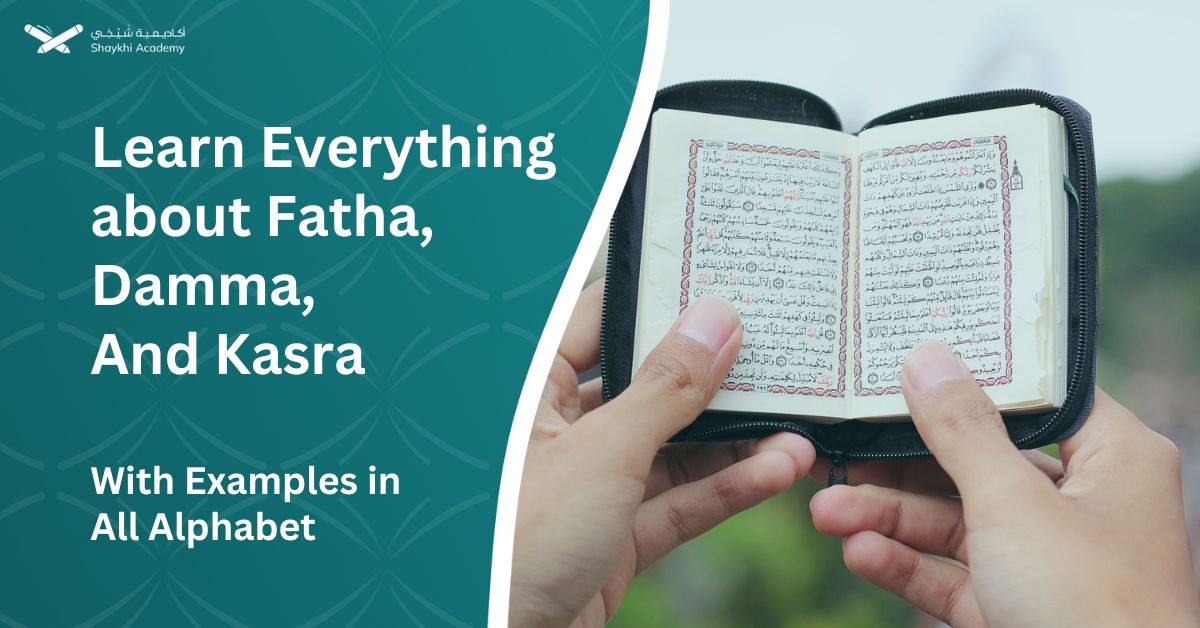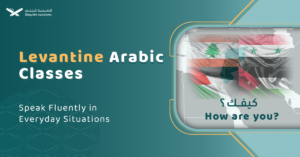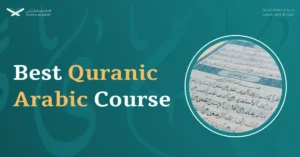Fatha, Kasra, and Damma are diacritical marks used in the Arabic script to indicate short vowels, crucial for maintaining correct pronunciation. Fatha represents the “a” sound, Kasra the “e” sound, and Damma the “o” sound.
They are essential for reading and reciting Arabic accurately, particularly in contexts like the Quran. Understanding them is fundamental for learners, and courses like those offered at Shaykhi Academy provide structured guidance.
Fatha, Kasra, and Damma are particularly important in the recitation of the Quran, where precise pronunciation is essential for conveying the intended meaning. Fatha, Kasra, and Damma help to differentiate between words that would otherwise be spelled the same way but have different meanings.
Introduction To Short Vowels in Arabic:
Short vowels in Arabic, known as Harakat, are diacritical marks used to guide proper pronunciation by indicating vowel sounds. The primary short vowels are:
Damma (ـُ): Placed above a letter, it creates a “u” sound.
Example: بُومة (Boomah – “owl”).
Fatha (ـَ): Placed above a letter, it produces an “a” sound.
Example: كَتَبَ (Kataba – “wrote”).
Kasra (ـِ): Positioned below a letter, it gives an “i” sound.
Example: بِنت (Bint – “girl”).
Linguistic scholars have used these diacritical phonetic signs; because some Arabic words have the exact same spelling, but have different meanings; so using these diacritical phonetic symbols help clarify the right pronunciation of a word, subsequently, they clear its right meaning.
Fatha Damma and Kasra In Arabic
Fatha, Damma, and Kasra are diacritical marks used in the Arabic script to indicate short vowels. They are positioned either above or under an Arabic letter.
They are crucial to maintain the correct pronunciation of a word, and are often used in the Quran and other Arabic texts to ensure proper recitation. One way to practice them is by enrolling in a Quranic recitation course such as the one at Shaykhi Academy; as the tutors will make sure you master them.
What is Fatha in Arabic?
Fatha is one of the Arabic short vowels. It is seated above the intended letter not under it. Its shape is represented by drawing a small slanted line above the letter: (ـــَــ). The accurate pronunciation of Fatha is to be articulated as the sound of (Aa).
To make it more clear, notice the pronunciation of the letter with Fatha in the following example:
أَسَد (Lion): Asad
َكَتَب (Wrote): Katab
What is Kasra in Arabic?
Kasra is the second member of the Arabic short vowel Harakat. Its seated position is under the intended letter not above it. Its shape is represented by drawing a small slanted line placed under the letter: (ـــِــ). The accurate pronunciation of Kasra is to be articulated as the sound of the English letter (Ee).
The following examples will help you understand how the Kasra plays out in formulating the pronunciation of the word:
بِنت (Girl): Bent
أنتِ (You): Ante
What is Damma in Arabic?
Damma is the third member of the Arabic short vowels. It is seated above the intended letter not under it. Its shape is represented by drawing a loop character: (ـــُــ). It is typically similar to the shape of the Arabic letter (و). The accurate pronunciation of Damma is to be articulated as the sound of the English letter (O).
The Damma is amongst the elements that determine the pronunciation of a word as follows:
بُومة (Owl): Bomah
دُب (Bear): Dob
The Arabic Alphabet with Fatha In Words:
The Arabic alphabet consists of 28 letters, each representing a unique sound. Fatha changes the pronunciation of the letter to include the “a” sound. Understanding Fatha and its application is fundamental in reading and pronouncing words correctly in Arabic.
The Arabic alphabet with Fatha is one of the fun grammatical lessons taught in Shaykhi Academy’s Arabic classes for beginners; as different game-like techniques are usually immersed in the process.
| The Arabic Letter | Its Fatha Version | The Word | Its Pronounciation |
| أ | أَ (Aa) | أمل | Amal |
| ب | بَ (Ba) | باب | Bab |
| ت | تَ (Ta) | تمر | Tamr |
| ث | ثَ (Tha) | ثلج | Thalj |
| ج | جَ (Ga) | جنة | Gannah |
| ح | حَ (Ha) | حديقة | Hadeqah |
| خ | خَ (Kha) | خاتم | Khatem |
| د | دَ (Da) | دار | Dar |
| ذ | ذَ (Tha) | ذيل | Thail |
| ر | رَ (Ra) | رجل | Rajul |
| ز | ز (Za) | زهرة | Zahra |
| س | س (Sa) | سمكة | Samakah |
| ش | شَ (Sha) | شجرة | Shagarah |
| ص | صَ (Sa) | صبر | Sabr |
| ض | ضَ (Da) | ضرب | Darb |
| ط | طَ (Ta) | طلب | Talab |
| ظ | ظَ (Tha) | ظبي | Thabi |
| ع | عَ (Aa) | عين | Aayn |
| غ | غَ (Gha) | غداً | Ghadan |
| ف | فَ (Fa) | فانوس | Fanos |
| ق | قَ (Qa) | قمر | Qamar |
| ك | كَ (Ka) | كلب | Kalb |
| ل | لَ (La) | لمس | Lamas |
| م | مَ (Ma) | ماء | Maa |
| ن | نَ (Na) | نهر | Nahr |
| ه | هَ (Ha) | هواء | Hawaa’ |
| و | وَ (Wa) | ورق | Waraq |
| ي | يَ (Ya) | يوم | Yawm |
The Arabic Alphabet with Kasra In Words:
Kasra is a diacritical mark that accompanies the Arabic letters to modify its pronunciation to include the “i” sound. Understanding Kasra is essential for proper pronunciation and comprehension of Arabic text.
For native Arabs, such lessons usually target young kids; so, maybe enrolling your kid in an Arabic course for kids; such as: the Arabic classes for kids at Shaykhi Academy is a good idea to get them to learn some Arabic from a young age.
| The Arabic Letter | Its Kasra Version | The Word | Its Pronounciation |
| أ | إِ (Ee) | إبرة | Eebra |
| ب | بِ (Be) | بئر | Be’r |
| ت | تِ (Te) | تين | Teen |
| ث | ثِ (The) | ثياب | Theyab |
| ج | جِ (Ge) | جبال | Gebal |
| ح | حِ (He) | حمار | Hemar |
| خ | خِ (Khe) | خيار | Kheyar |
| د | دِ (De) | ديوان | Dewan |
| ذ | ذِ (The) | ذئب | The’b |
| ر | رِ (Re) | رياح | Reyah |
| ز | زِ (Ze) | زلزال | Zelzal |
| س | سِ (Se) | سر | Ser |
| ش | شِ (She) | شفاء | Shefaa’ |
| ص | صِ (Se) | صفر | Sefr |
| ض | ضِ (De) | ضرس | Ders |
| ط | طِ (Te) | طفل | Tefl |
| ظ | ظِ (The) | ظل | Thel |
| ع | عِ (Ee) | علم | Eelm |
| غ | غِ (Ghe) | غذاء | Ghethaa’ |
| ف | فِ (Fe) | فتنة | Fetnah |
| ق | قِ (Qe) | قرد | Qerd |
| ك | كِ (Ke) | كتاب | Ketab |
| ل | لِ (Le) | لسان | Lesan |
| م | مِ (Me) | من | Men |
| ن | نِ (Ne) | نصف | Nesf |
| ه | هِ (He) | هرة | Herrah |
| و | وِ (We) | وتر | Wetr |
| ي | يِ (Ye) | ين | Yen |
The Arabic Alphabet with Damma In Words:
The Arabic alphabet is a writing system used for the Arabic language, consisting of 28 letters. Each letter represents a consonant sound, and additional diacritic marks, such as Damma, indicate short vowels.
Many Academic Arabic books, including the Menhaj book, focus on the Damma and the other Harakat in an attempt to facilitate the processes of pronunciation for Arabic learners.
| The Arabic Letter | Its damma Version | The word | Its Pronounciation |
| أ | أُ (Oo) | أم | Oom |
| ب | بُ (Bo) | برتقال | Bortoqal |
| ت | تُ (To) | تفاح | Tofah |
| ث | ثُ (Tho) | ثعبان | Thoban |
| ج | جُ (Go) | جمرك | Gomrok |
| ح | حُ (Ho) | حر | Hor |
| خ | خُ (Kho) | خبز | Khobz |
| د | دُ (Do) | دف | Dof |
| ذ | ذُ (Tho) | ذل | Thol |
| ر | رُ (Ro) | رعب | Ro’b |
| ز | زُ (Zo) | زجاج | Zogag |
| س | سُ (So) | سم | Som |
| ش | شُ (Sho) | شعبة | Shobah |
| ص | صُ (So) | صورة | Sorah |
| ض | ضُ (Do) | ضوء | Do’o |
| ط | طُ (To) | طرقة | Torqah |
| ظ | ظُ (Tho) | ظلم | Tholm |
| ع | عُ (Oo) | عرف | Oorf |
| غ | غُ (Gho) | غربة | Ghorbah |
| ف | فُ (Fo) | فرسان | Forsan |
| ق | قُ (Qo) | قبة | Qobah |
| ك | كُ (Ko) | كرسي | Korsei |
| ل | لُ (Lo) | لبنان | Lobnan |
| م | مُ (Mo) | ممتاز | Momtaz |
| ن | نُ (No) | نور | Nor |
| ه | هُ (Ho) | هدهد | Hodhod |
| و | وُ (Wo) | ورود | Worod |
| ي | يُ (Yo) | يسر | Yosr |
What Is the difference between Fatha, Kasra, and Damma?
Although Fatha, Kasra, and Damma play the same role regarding the pronunciation of different Arabic sounds, they play those roles quite differently.
The main difference is that Fatha (ـَ) signifies “a,” Kasra (ـِ) stands for “e,” and Damma (ـُ) represents “o.” They’re diacritical marks in Arabic indicating short vowel sounds.
| Fatha | Kasra | Damma |
| Fatha (ـَ) is a short diagonal line placed above a letter and represents the “a” sound. | Kasra (ـِ) is a short diagonal line placed below a letter and represents the “e” sound. | Damma (ـُ) is a small curl placed above a letter and represents the “o” sound. |
Learn Arabic Online with Shaykhi Academy’s Native Tutors!
Our Arabic course at Shaykhi Academy offers a comprehensive and structured approach to mastering the Arabic language. Whether you’re a beginner or looking to enhance your skills, our qualified teachers provide personalized instruction to suit your learning goals.
The process of learning the Arabic language is an ongoing process without stopping. The best way to learn the Arabic language is to find a native Arab tutor who is well qualified, such as the ones hired by Shaykhi Academy. They will help you learn the language accurately and in an expeditious manner.
Join our interactive classes and immerse yourself in the beauty of Arabic language and culture. Enroll now to start your journey towards fluency!
Conclusion:
In conclusion, mastering Fatha, Kasra, and Damma is vital for anyone seeking proficiency in Arabic reading and pronunciation. These diacritical marks ensure clarity and accuracy in understanding the language, facilitating effective communication and comprehension.
Whether learning from academic textbooks or through specialized courses, grasping these fundamentals opens the door to a deeper understanding of the Arabic language and its rich literary heritage.
Fatha, Kasra, and Damma are crucial for learners of Arabic as a second language, as they provide guidance on how words should be pronounced.















































